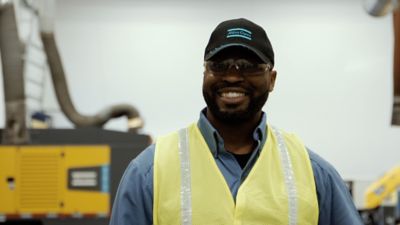Why to use nitrogen for fire suppression
As part of a comprehensive fire management plan, it's important to consider the right fire suppression method. After prevention and protection, suppression is the last line of defense from damage and destruction. Common types of suppression include gas, chemical foam, water mist, foam deluge, and pneumatic heat.
If you work in a facility with expensive electrical equipment, using a suppression system with water/liquids can result in unnecessary costly damage. Nitrogen (N2) works by reducing the oxygen level in the space to where (typically below 15%) the fire will extinguish automatically. This is ideal for protecting electronics and machinery, such as air compressors.
Even if water-damaged electronics aren't a concern regarding fire suppression, N2 can still be beneficial in so-called dry pipe sprinkler systems. Here, N2 serves as a supervisory gas, filling the pipes rather than water. A dry pipe valve only allows water to enter the pipes when a fire sets off one or more sprinklers. This set-up prevents water vapor and oxygen (O2) in pipes to cause corrosion and bacteria.
Read on below to learn more about the working principle of an N2 flame suppression system. We also explain why generating your own N2 supply is recommended.
What is an N2 fire suppression system
The air we breathe contains 21% O2, 78% N2, and 1% other gasses. That said, normal O2 levels can fuel and spread fire. With N2 flame suppression, the goal is to reduce O2 levels by injecting N2 into the air. When this occurs, air flammability is reduced, suffocating the fire.
The way this works is via a sprinkler system which uses N2. As mentioned, this is a great alternative to liquid suppression, as it greatly reduces the potential for corrosion in the pipes as well as water damage.
Where N2 fire suppression is useful
Due to the fact that N2 suppression contains no toxic chemicals, and doesn't involve liquid, it's good for nearly any facility. With that, it's most useful for rooms with computers, servers, and large machines.
It's also worth pointing out that electrical fires are one of the most common types. These tend to result from poor maintenance or overworking equipment. Regardless of what suppression method is used, it's recommended to have a fire prevention plan in place. This includes staff training, inspections, and proper ventilation.
On-site N2 generation
When using N2 for fire suppression, you want purity levels between 90 and 97%. With this, on-site generation is a good idea. It both allows you to control your supply and choose the right purity level. In addition, it saves money compared to N2 delivery services. In fact, on-site generation can reduce costs by up to 80%.
On top of this, on-site generation is better for the environment. You won't need transport vehicles to deliver N2 to your facility. These release CO2 into the atmosphere. Also, on a related note, you'll save time by not managing logistics. In general, there are two ways to generate N2 on-site. These are membrane and pressure swing adsorption (PSA).
Both are fed from an air compressor, and separate N2 from O2. With the purity levels required for flame suppression, a membrane generator is sufficient. It's less expensive to purchase than a PSA generator and produces N2 with up to 99.5% purity. You can read more about the differences between the two below.
Membrane
As mentioned, N2 membrane generators are a robust solution, offering nitrogen with a purity of up to 99.5%. Their working principle centers around a membrane through which compressed air is pushed. O2 and water vapor permeate the membrane fiber and are vented out, leaving just dry N2 at the membrane’s outlet. It's also worth mentioning that this equipment requires very little maintenance.
However, depending on the flow rate and purity needed, membrane generators may not be ideal. That said, they are generally good for fire suppression. With any air / gas equipment, you want to choose the right one to meet requirements of the intended application.
PSA
A PSA N2 generator is best for high flow applications requiring up to 99.999% purity. This two-tower setup involves a carbon molecular sieve (CMS). As compressed air is pushed through, the oxygen molecules in the air bind themselves to this adsorbent, separating the N2.
When the adsorbent becomes saturated with O2, the second tower takes over N2 generation while the first one regenerates its adsorbent. It will be ready for use when the second tower needs regeneration. As a result of this two-tower set-up, PSA generators typically are more expensive to buy and require more maintenance than membrane.
We're here to help
We hope the information contained in this article is helpful in better understanding why N2 is ideal for fire suppression. If you'd like more information about any topic covered, including the right N2 generator, please reach out. Our team is happy to point you in the right direction.



